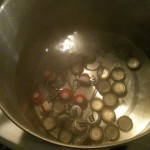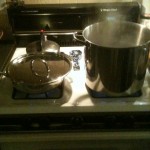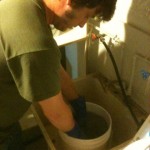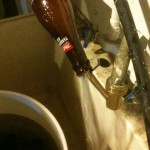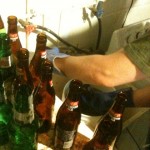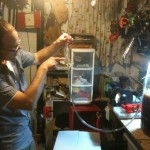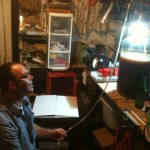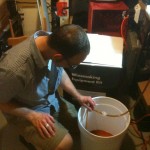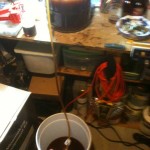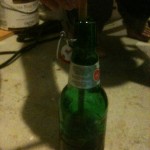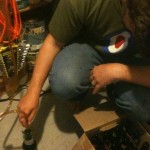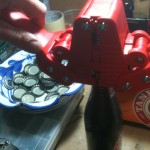Well, after 6 or 7 days the fermentation stopped and I figured it was time to get the beer out of the primary fermenter (what I understand they call a carboy) and into the bottles.
Lucky for me, my favourite baffled expert came over to give me a hand.
The first thing to do was — that’s right — sanitize. I got the long straw and so I sanitized the bottle caps and fumper caps for the Grolsch bottles. I say fumper because that’s the sound they make when you pop them, “fump”. I just boiled them in water for a few minutes.
The other key part is to dissolve the priming sugar, which gets added to the fermented wort.
Of course, the bottles also need to be sanitized.
And then the siphoning begins. I really must get better at this.
Oh, wait — I had added the dissolved sugar into the great big white barrel first. Then we started the siphoning action. It was a bit frustrating, and there’s something about a loop that we didn’t quite manage correctly — better luck next time, I suppose — but we were eventually able to draw a successful siphon from the primary fermenting jug to the bottling jug.
Apparently it’s very important to pour some water in the hose before you start siphoning. This creates a vacuum in the hose, which — when lowered below the level of the primary jug from which the fluid is being drawn — creates the necessary conditions to get the wort from the primary fermenting jug into the great white bottling vat without having to pour it.
I also bought a nifty little valve thingy that I plugged onto the end of the siphon hose (the fermenting jug end having its own special 7-shaped, foot valve enabled action) that made it really easy to start and stop the siphon with a simple depression. Not that beer’s a depressant. Even though it is. But really, it’s much too much fin making beer for it to be depressing.
So, once the vacuum in the siphon tube has been created, we started siphoning the beer into the sanitized bottles. We splished and splashed a bit, but all in all were able to fill 36 340mL bottles and 8 440mL bottles (the ones with the tops that go ‘fump’) with delicious, newly fermented beer.
I know it’s delicious because I tried some.
Even though it’s only at about 3% alcohol action at this stage (before the additional in-bottle fermentation that takes place once the beer’s been siphoned into the bottles and capped), the beer tasted fresh and acceptable. The carbonation was very low — even lower than something like Kilkenney — but marginally there. The sugar helps create the carbonation.
The final step was to cap’em. Thankfully, the beer making kit came with a bottle capper thingy and the box I ordered from Brewer’s Best came with bottle caps.
After a couple of weeks in the bottles with the addition of the priming sugar it should be bubbly goodness. American Amber bubbly goodness.
Thanks also to How To Brew.com. That site’s awesome, even though I didn’t follow the directions exactly.
